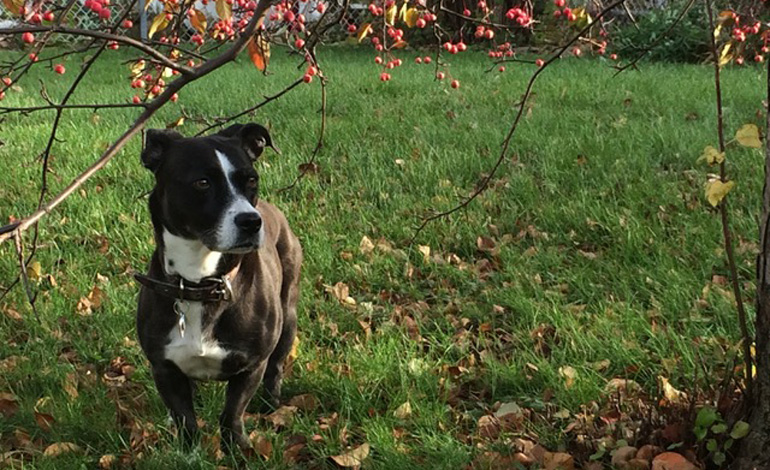My dog will soon be 12 years old. Sooner or later—it’s inevitable—she’ll pass away and leave a gaping hole in my life. In the past, when the thought of Dina’s death has got me down, I’ve comforted myself with my plan to bury her in the garden, at the foot of the magnolia, in a beautiful box with her collar and her favourite toy.
Dina, the author’s loyal friend, under an apple blossom in the yard.
Alas, I recently found out that in Quebec, where I live, for environmental and public health reasons, it’s illegal to bury your animal in your yard. According to the provincial Ministry of the Environment and Climate Control, the cadavers of companion animals and their ashes are contaminants that may pollute ground, water and air. Never mind how much we’ve loved them during their lives, our pet’s remains are considered residual matter and their disposal is regulated by the ministry. In other words, Dina’s body could attract vermin and contaminate the soil or a source of drinking water.
Meanwhile, next door
In other Canadian provinces, especially beyond the larger cities, laws tend to be less strict than in Quebec. In British Columbia, while it’s illegal to bury a pet in your yard in Vancouver and Victoria, many towns in rural areas permit it.
In New Brunswick and Ontario (including Fredericton and Toronto), burying a pet in your yard isn’t against the law. Although these provinces suggest that the burial site be 2 to 4 feet deep and situated away from a source of water. They also stipulate that the animal not be wrapped in plastic (which would hinder decomposition).
Some provinces, including Saskatchewan, permit pet owners to spread their animal’s ashes in their yards. But in some cities, such as Ottawa, this practice is illegal.
To find out what you can and can’t do where you live, it’s best to check with your municipality.
Aligning dreams with reality
No one will ever know and no one can stop me from burying Dina at night in my garden. That at least is what I tell myself. Until a friend makes me realize that my plan may not be as poetic as I think: “You’ll have to carry your dog’s stiff body and if it’s winter, the ground will be frozen solid, so you’ll have to keep Dina in your freezer for a few months. And what if you decide to move?”

I decide to explore other options, the most popular being cremation. If I go this route, I’ll be able to put some of Dina’s ashes in a piece of jewelry or a reliquary of some sort. I could also keep them in an urn at home, place them in a columbarium or have them buried in a cemetery. Maybe one day, I could even be buried at Dina’s side? Aquamation is also an option; a process which dissolves the body in water, which is supposedly better for the environment than cremation.
There’s also “traditional” burial—with a coffin—which is what people did during my grandparents’ time. After all, pet cemeteries are popping up all over the place. Or I could pay tribute to Dina in a virtual cemetery? More original than that: I could use a biodegradable urn in combination with a branch cutting and see a beautiful tree grow from her ashes.
Whatever I decide to do with Dina’s body, I know that I’ll heal from her death more easily by marking the event with a ritual. On this point, and for some books written to help animal lovers express the grief related to the loss of a pet, visit theralphsite.com.
Credit: Louise Dugas
